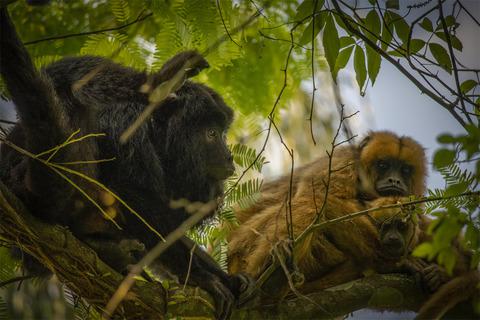当前位置:
X-MOL 学术
›
Mammal Rev.
›
论文详情
Our official English website, www.x-mol.net, welcomes your
feedback! (Note: you will need to create a separate account there.)
Sexual size dimorphism and sexual selection in primates
Mammal Review ( IF 4.3 ) Pub Date : 2020-04-07 , DOI: 10.1111/mam.12191 Marcelo H. Cassini 1
Mammal Review ( IF 4.3 ) Pub Date : 2020-04-07 , DOI: 10.1111/mam.12191 Marcelo H. Cassini 1
Affiliation

|
In most animals, females are larger than males. Paradoxically, sexual size dimorphism is biased towards males in most mammalian species. An accepted explanation is that sexual dimorphism in mammals evolved by intramale sexual selection. I tested this hypothesis in primates, by relating sexual size dimorphism to seven proxies of sexual selection intensity: operational sex ratio, mating system, intermale competition, group sex ratio, group size, maximum mating percentage (percentage of observed copulations involving the most successful male), and total paternity (a genetic estimate of the percentage of young sired by the most successful male). I fitted phylogenetic generalised least squares models using sexual size dimorphism as the dependent variable and each of the seven measures of intensity of sexual selection as independent variables. I conducted this comparative analysis with data from 50 extant species of primates, including Homo sapiens, Pan troglodytes, and Gorilla spp. Sexual dimorphism was positively related to the four measures of female monopolisation (operational sex ratio, mating system, intermale competition, and group sex ratio) and in some cases to group size, but was not associated with maximum mating percentage or total paternity. Additional regression analyses indicated that maximum mating percentage and total paternity were negatively associated with group size. These results are predicted by reproductive skew theory: in large groups, males can lose control of the sexual behaviour of the other members of the group or can concede reproductive opportunities to others. The results are also consistent with the evolution of sexual size dimorphism before polygyny, due to the effects of natural, rather than sexual, selection. In birds, the study of molecular paternity showed that variance in male reproductive success is much higher than expected by behaviour. In mammals, recent studies have begun to show the opposite trend, i.e. that intensity of sexual selection is lower than expected by polygyny. Results of this comparative analysis of sexual size dimorphism and sexual selection intensity in primates suggest that the use of intramale sexual selection theory to explain the evolution of polygyny and sexual dimorphism in mammals should be reviewed, and that natural selection should be considered alongside sexual selection as an evolutionary driver of sexual size dimorphism and polygyny in mammals.
中文翻译:

灵长类动物的性大小二态性和性选择
在大多数动物中,雌性比雄性大。矛盾的是,在大多数哺乳动物物种中,性别大小二态性偏向于雄性。一个公认的解释是哺乳动物的性别二态性是由雄性内的性选择进化而来的。我在灵长类动物中测试了这个假设,将性大小二态性与性选择强度的七个代理联系起来:操作性性别比、交配系统、雄性间竞争、群体性别比、群体规模、最大交配百分比(观察到的最成功雄性交配的百分比) ),以及总亲子关系(对最成功的男性所生后代的百分比的遗传估计)。我使用性别大小二态性作为因变量,将性选择强度的七个度量中的每一个作为自变量来拟合系统发育广义最小二乘模型。我使用来自 50 种现存灵长类动物的数据进行了这项比较分析,包括智人、Pan troglodytes 和大猩猩。性别二态性与女性垄断的四项指标(可操作的性别比例、交配系统、男性间竞争和群体性别比例)呈正相关,在某些情况下与群体规模呈正相关,但与最大交配百分比或总亲子关系无关。额外的回归分析表明,最大交配百分比和总亲子关系与群体规模呈负相关。这些结果是由生殖偏斜理论预测的:在大群体中,雄性可能会失去对群体其他成员性行为的控制,或者可能将生殖机会让给他人。结果也与一夫多妻之前性别大小二态性的演变一致,由于自然而非性选择的影响。在鸟类中,分子亲子关系研究表明,雄性繁殖成功率的差异远高于行为预期。在哺乳动物中,最近的研究开始显示出相反的趋势,即性选择的强度低于一夫多妻制的预期。灵长类动物性别大小二态性和性选择强度的比较分析结果表明,应该审查使用雄性内性选择理论来解释哺乳动物的一夫多妻和性二态性的进化,并且应该将自然选择与性选择一起考虑为哺乳动物性别大小二态性和一夫多妻的进化驱动因素。分子亲子关系研究表明,男性生殖成功率的差异远高于行为预期。在哺乳动物中,最近的研究开始显示出相反的趋势,即性选择的强度低于一夫多妻制的预期。灵长类动物性别大小二态性和性选择强度的比较分析结果表明,应该审查使用雄性内性选择理论来解释哺乳动物的一夫多妻和性二态性的进化,并且应该将自然选择与性选择一起考虑为哺乳动物性别大小二态性和一夫多妻的进化驱动因素。分子亲子关系研究表明,男性生殖成功率的差异远高于行为预期。在哺乳动物中,最近的研究开始显示出相反的趋势,即性选择的强度低于一夫多妻制的预期。灵长类动物性别大小二态性和性选择强度的比较分析结果表明,应该审查使用雄性内性选择理论来解释哺乳动物的一夫多妻和性二态性的进化,并且应该将自然选择与性选择一起考虑为哺乳动物性别大小二态性和一夫多妻的进化驱动因素。性选择的强度低于一夫多妻制的预期。灵长类动物性别大小二态性和性选择强度的比较分析结果表明,应该审查使用雄性内性选择理论来解释哺乳动物的一夫多妻和性二态性的进化,并且应该将自然选择与性选择一起考虑为哺乳动物性别大小二态性和一夫多妻的进化驱动因素。性选择的强度低于一夫多妻制的预期。灵长类动物性别大小二态性和性选择强度的比较分析结果表明,应该审查使用雄性内性选择理论来解释哺乳动物的一夫多妻和性二态性的进化,并且应该将自然选择与性选择一起考虑为哺乳动物性别大小二态性和一夫多妻的进化驱动因素。
更新日期:2020-04-07
中文翻译:

灵长类动物的性大小二态性和性选择
在大多数动物中,雌性比雄性大。矛盾的是,在大多数哺乳动物物种中,性别大小二态性偏向于雄性。一个公认的解释是哺乳动物的性别二态性是由雄性内的性选择进化而来的。我在灵长类动物中测试了这个假设,将性大小二态性与性选择强度的七个代理联系起来:操作性性别比、交配系统、雄性间竞争、群体性别比、群体规模、最大交配百分比(观察到的最成功雄性交配的百分比) ),以及总亲子关系(对最成功的男性所生后代的百分比的遗传估计)。我使用性别大小二态性作为因变量,将性选择强度的七个度量中的每一个作为自变量来拟合系统发育广义最小二乘模型。我使用来自 50 种现存灵长类动物的数据进行了这项比较分析,包括智人、Pan troglodytes 和大猩猩。性别二态性与女性垄断的四项指标(可操作的性别比例、交配系统、男性间竞争和群体性别比例)呈正相关,在某些情况下与群体规模呈正相关,但与最大交配百分比或总亲子关系无关。额外的回归分析表明,最大交配百分比和总亲子关系与群体规模呈负相关。这些结果是由生殖偏斜理论预测的:在大群体中,雄性可能会失去对群体其他成员性行为的控制,或者可能将生殖机会让给他人。结果也与一夫多妻之前性别大小二态性的演变一致,由于自然而非性选择的影响。在鸟类中,分子亲子关系研究表明,雄性繁殖成功率的差异远高于行为预期。在哺乳动物中,最近的研究开始显示出相反的趋势,即性选择的强度低于一夫多妻制的预期。灵长类动物性别大小二态性和性选择强度的比较分析结果表明,应该审查使用雄性内性选择理论来解释哺乳动物的一夫多妻和性二态性的进化,并且应该将自然选择与性选择一起考虑为哺乳动物性别大小二态性和一夫多妻的进化驱动因素。分子亲子关系研究表明,男性生殖成功率的差异远高于行为预期。在哺乳动物中,最近的研究开始显示出相反的趋势,即性选择的强度低于一夫多妻制的预期。灵长类动物性别大小二态性和性选择强度的比较分析结果表明,应该审查使用雄性内性选择理论来解释哺乳动物的一夫多妻和性二态性的进化,并且应该将自然选择与性选择一起考虑为哺乳动物性别大小二态性和一夫多妻的进化驱动因素。分子亲子关系研究表明,男性生殖成功率的差异远高于行为预期。在哺乳动物中,最近的研究开始显示出相反的趋势,即性选择的强度低于一夫多妻制的预期。灵长类动物性别大小二态性和性选择强度的比较分析结果表明,应该审查使用雄性内性选择理论来解释哺乳动物的一夫多妻和性二态性的进化,并且应该将自然选择与性选择一起考虑为哺乳动物性别大小二态性和一夫多妻的进化驱动因素。性选择的强度低于一夫多妻制的预期。灵长类动物性别大小二态性和性选择强度的比较分析结果表明,应该审查使用雄性内性选择理论来解释哺乳动物的一夫多妻和性二态性的进化,并且应该将自然选择与性选择一起考虑为哺乳动物性别大小二态性和一夫多妻的进化驱动因素。性选择的强度低于一夫多妻制的预期。灵长类动物性别大小二态性和性选择强度的比较分析结果表明,应该审查使用雄性内性选择理论来解释哺乳动物的一夫多妻和性二态性的进化,并且应该将自然选择与性选择一起考虑为哺乳动物性别大小二态性和一夫多妻的进化驱动因素。











































 京公网安备 11010802027423号
京公网安备 11010802027423号